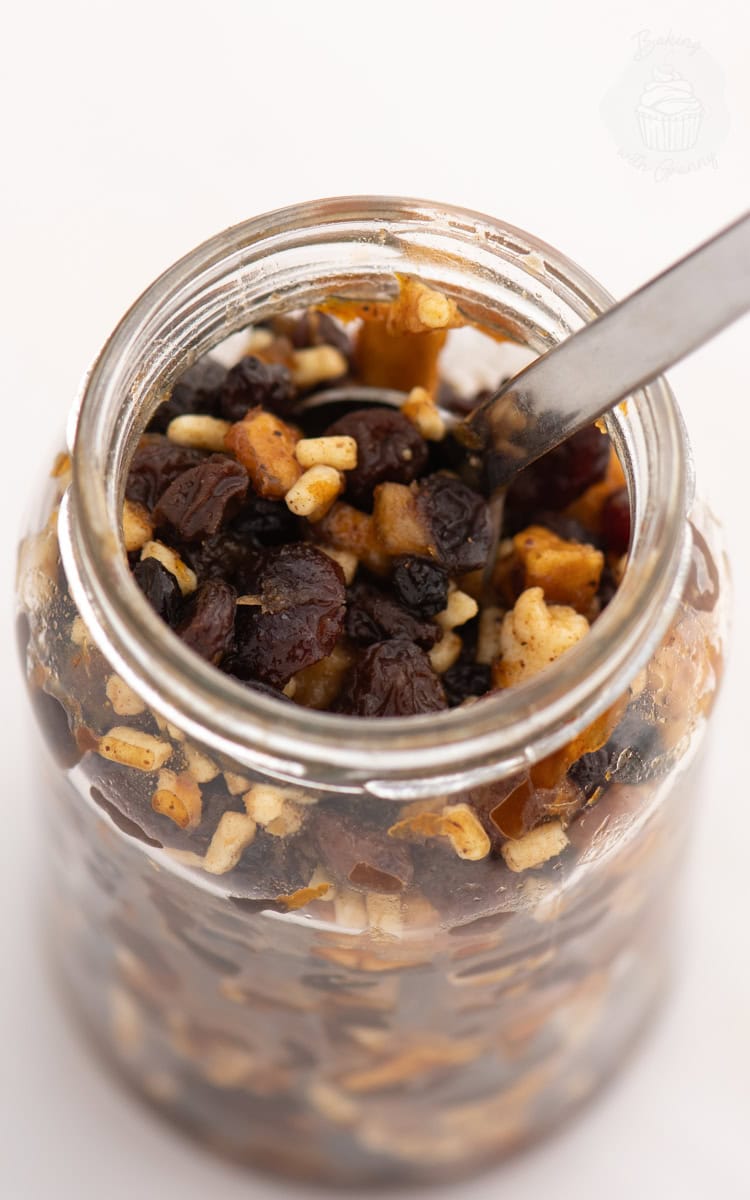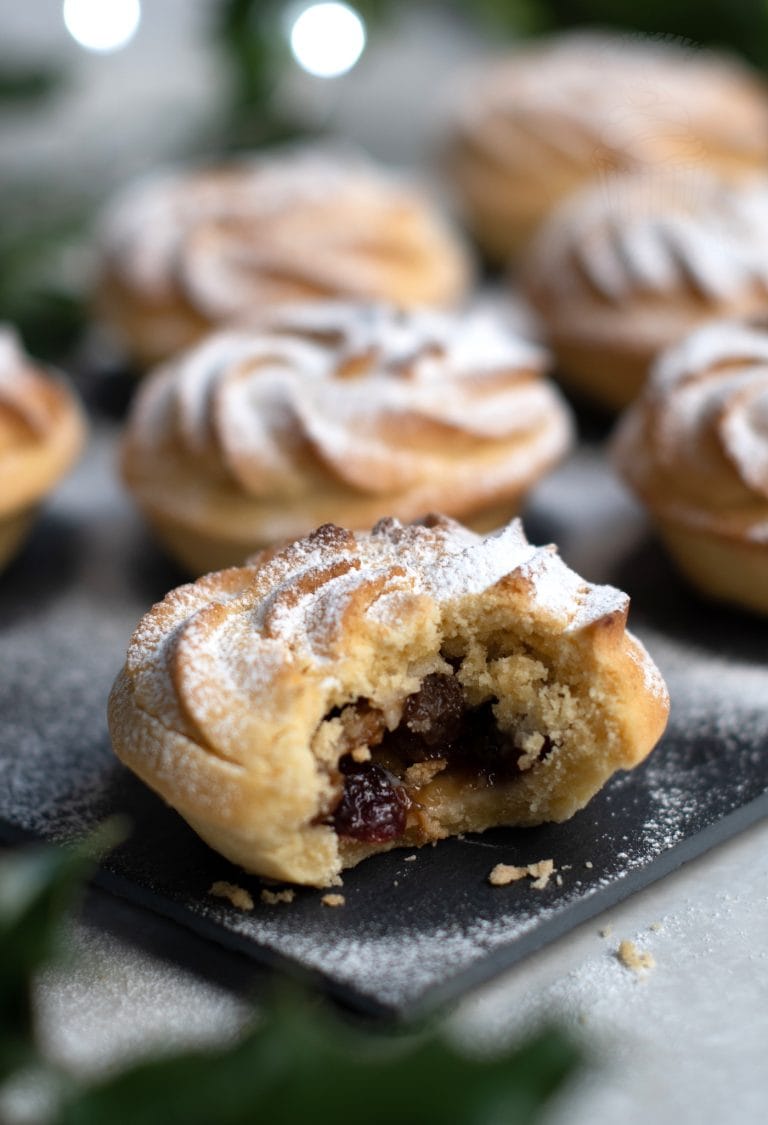Christmas Mincemeat
Easy homemade Christmas mincemeat made with dried fruit, suet and spices – the perfect filling for classic British mince pies. And best of all, no cooking required!
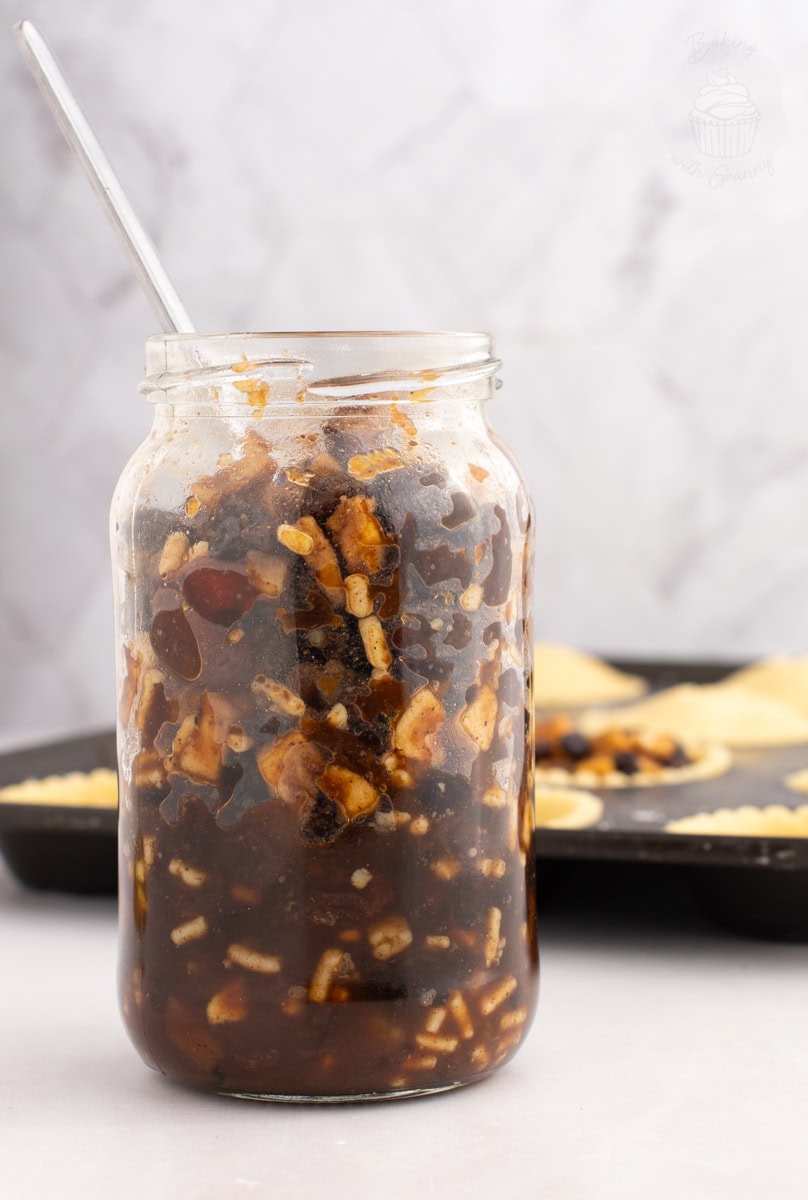
I’ll be honest… Mince pies were never something I ate while growing up. They always felt like more of a “grown-up” Christmas treat, something my Dad enjoyed, so I just never really tried them. But once I hit adulthood and came around to the idea of dried fruit, I finally tried a mince pie.
Now I’m that person sneaking a box of Christmas mince pies into my basket, the minute they land in the supermarkets… in October. But, of course, nothing beats homemade, like my Puff Pastry Mince Pies, Crumble Top Mince Pies and Viennese Whirl Mince Pies.
But what is actually inside a mince pie?? Well, mincemeat, of course!
Mincemeat is a traditional British Christmas staples. Made with a mix of dried fruits, spices, apples, sugar, and suet, all soaked together until it’s full of festive flavour. Despite the name, you won’t find meat in modern mincemeat; although, yes, it did used to be made with meat! And that’s why you still get bits of suet in mincemeat, although generally it will be vegetable suet nowadays.
If you’ve never made your own mincemeat before, it’s genuinely so simple. No cooking, no faff – just pop everything into a bowl, mix it together, and let it sit so all the flavours can soak together. As it rests, the dried fruit plumps up beautifully, and the whole mixture becomes miles better than anything shopbought. It keeps brilliantly too, and makes a lovely homemade gift for the holiday season.
Once you’ve got a few jars ready, you can whip up mince pies whenever you fancy – whatever time of the year, I won’t judge!
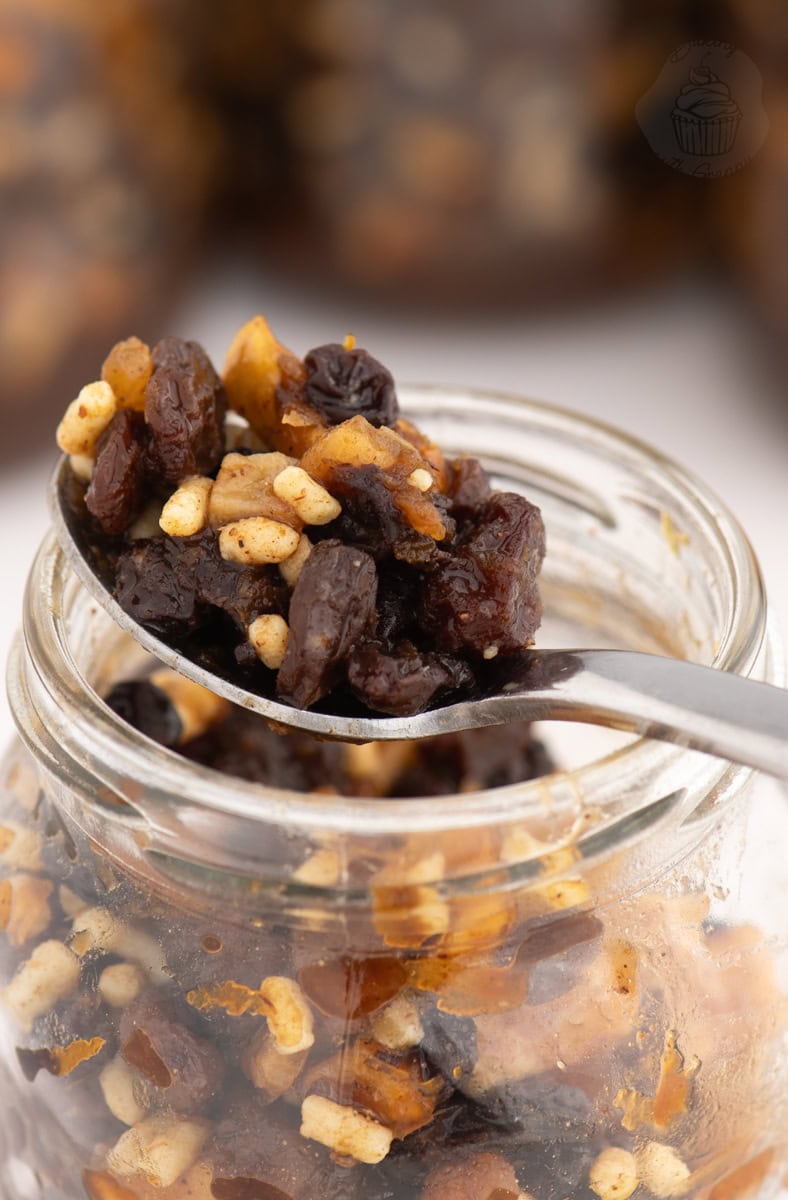
Top Tips for homemade Mincemeat:
• Use good-quality dried fruit: You can use whatever dried fruit you have but if you want a really special mincemeat, opt for the luxury dried fruit range.
• Don’t skip the soaking time: This is when the magic happens! A few days sitting and soaking allows the fruit to plump and the flavours to develop properly. You can use it straight away in a pinch, but it’ll be much drier and less flavourful.
• Stir it every day (if you remember!): Giving the mixture a wee stir once a day helps distribute the juices and spices evenly. Don’t worry if you forget, though – it’ll still be lovely.
• Adjust the spice to your taste: If you like a stronger cinnamon or nutmeg flavour, you can increase those a little. Or if you prefer a milder tasting mincemeat, simply reduce the spices down.
• Add a splash of brandy…or don’t: Brandy is traditional in a festive mincemeat, but in this recipe it is an optional extra. Meaning if you’re not a fan, you don’t have to add it – they’re still plenty of flavour from all the spices, zests and juices.
• Use sterilised jars for longest shelf life: As this is a no-cook recipe, clean jars are essential. A quick wash and bake in the oven (or a hot dishwasher cycle) keeps everything sterile for long-term storage.
• Leave a little headspace when jarring: The fruit can continue to plump in the jars, so don’t pack them too tightly. A centimetre of space left at the top of the jar is perfect.

Save this recipe!
Want to save this recipe for later? Pop your email below and come back to it when you’re ready to bake.
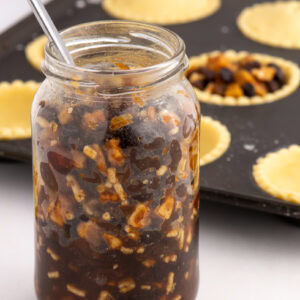
INGREDIENTS
- 2 Apples (peeled, cored, cut into bite sized pieces)
- 115 g Sultanas
- 115 g Raisins
- 115 g Currants
- 60 g Dried Cranberries
- 60 g Glace Cherries (Candied Cherries) (quartered)
- 115 g Mixed Peel (Candied Mixed Peel)
- 115 g Suet (vegetable or beef)
- 200 g Soft Dark Brown Sugar
- 2 tsp Mixed Spice (Pumpkin Spice)
- 1/2 tsp Ground Nutmeg
- 1/2 tsp Ground Cinnamon
- 2 Oranges (zested & juiced)
- 2 Lemons (zested & juiced)
- Brandy or Sweet Sherry (optional)
INSTRUCTIONS
- Add all your ingredients into a large bowl and stir to combine and coat.
- Leave the mixture to soak and marinade for a few days (2-4 days is ideal), stirring once a day to ensure everything is coated and soaked.
- Spoon the mincemeat, using a slotted spoon, into sterilised jars. Fill the jars nearly full, but leave a little space at the top. You should get about 4 jars of mincemeat from this recipe. You may have some excess liquid – you can just discard this. Add the lids to the jars leave sealed until ready to use.
- The flavour of homemade mincemeat will continue to develop overtime, but can be used straightaway, after the initial few days of soaking. Otherwise, store the mincemeat in a cool, dark place, within the sealed jars, until ready to use.
Video
IMPORTANT NOTE:
All my recipes are developed using a digital scale and the metric system (grams and millilitres). Cup measurements are available as a conversion but these, unfortunately, won’t always be as accurate. For best results, I always recommend baking with a digital scale.
RECIPE NOTES:
Sterilise Jars:
As this is a no-cook recipe, clean, sterilised jars are essential. A quick wash of the jars and lids, and a bake in the oven at 140°c (120°c for fan-assisted ovens, Gas Mark 1, or 275°F) keeps everything sterile for long-term storage.Storage:
Homemade mincemeat keeps brilliantly, as long as you sterilise your jars – it also continues to develop in flavour. In sterilised jars, Christmas mincemeat will keep for up to a year in a sealed jar, stored in a cool dark place. Of course, always exercise caution and check your mincemeat before using.Substitutions:
- Suet: Vegetable suet is most common now, but beef suet works too if you want to give a nod to the “meat” in easy mincemeat.
- Alcohol: Some luxury shop-bought mincemeat will contain alcohol (usually brandy) but your average jar of mincemeat won’t. It’s entirely up to you if you wish to add alcohol to your homemade Christmas mincemeat. I don’t because it’s not to my taste but this recipe is entirely versatile and you can add as much or little alcohol as you’d like.
- Fruit: You can use any mix of raisins, sultanas, currants, cranberries, or mixed peel… Just keep the overall weight the same.
- Sugar: Light or dark brown sugar both work, but dark gives a richer flavour.
Mincemeat is a classic British Christmas mixture that you fill mince pies with. It is made from dried fruits, apples, suet, sugar, and festive spices. Everything is soaked together to create a rich, fruity filling, that taste of Christmas!
Historically, mincemeat did contain minced beef or lamb, mixed with fruit and spices as a way of preserving meat. Over time, the meat disappeared from the recipe, but the name stayed. The closest you will find to meat in Christmas mincemeat these days is beef suet, although most will now even use vegetable suet instead.
Yes, absolutely. In fact, I never add alcohol to mine as I don’t drink alcohol and don’t have any in the house, and it would otherwise go to waste for the sake of one recipe. Traditionally, the alcohol of choice of Christmas mincemeat would be brandy but a sweet sherry works well, too. But again, it’s purely optional and personal preference as to which or how much you use.
Homemade mincemeat keeps brilliantly, as long as you sterilise your jars – it will also continue to develop in flavour the longer you leave it. Christmas mincemeat will keep for up to a year in a sealed, sterilised jar, stored in a cool dark place. Of course, always exercise caution and check your mincemeat before using.
As this is a no-cook recipe, clean, sterilised jars are essential. A quick wash and bake in the oven at 120°c (or a hot dishwasher cycle) of the jars and lids keeps everything sterile for long-term storage.
Aside from mince pies, mincemeat is lovely in cakes, crumbles, scones, pastries, and even swirled through porridge for a festive breakfast.
Free-from & Vegan:
Gluten-Free: This mincemeat recipe is naturally gluten-free, as long as you use a certified gluten-free vegetable suet. Always double-check the ingredients, as some brands may include wheat flour as a stabiliser. Everything else in the recipe is naturally gluten-free.
Dairy-Free: Mincemeat is dairy-free by default when made with vegetable suet. Avoid beef suet if you need it to remain dairy-free, as some traditional brands may include traces of milk from processing.
Egg-Free: This recipe contains no eggs at all, meaning it is a fully egg-free mincemeat.
Nut-Free: The basse recipe here is a nut-free mincemeat, but always check ingredient labels for cross-contamination warnings, especially on mixed dried fruit.
Vegan: Mincemeat can easily be made vegan by using vegetable suet. All other ingredients are naturally plant-based.
N.B. Any advice or suggestions to make recipes “free-from” or vegan are purely that – suggestions. Please be careful to double-check all ingredients individually, taking extra caution when serving to those with allergies & intolerances.
For more info on common food allergies, please see food.gov.uk | For more info on coeliac disease, please see coeliac.org.uk | For more info on a vegan diet, please see vegansociety.com
